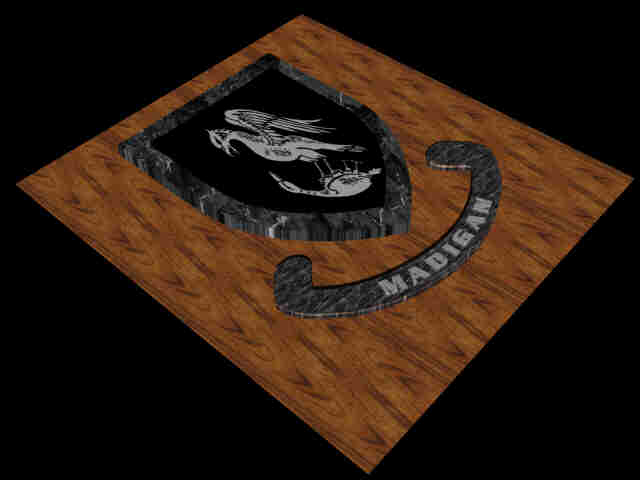Colonial Williamsburg
A living history park
Williamsburg, VA.
October 26 - November 2, 1999
"So,  what is the most significant
historical preservation in this great country?" This
question came back to me over and over again as I looked at the
pile of crumpled paper in the wastebasket. I normally just bang
out a line of prose, diving into a subject with little thought of
where I am going or where I will end up, but this was different.
Colonial Williamsburg was the most sprawling and complex
historical presentation I had ever experienced. Its 173 acres
with its 88 original 18th century buildings, among its 400 some
odd structures, created an unparalleled experience. With
literally thousands of employees, a carefully choreographed
format unveils before the unsuspecting visitor. It all started
routinely enough, with a visit to the public relations manager of
the Colonial Williamsburg Foundation. Lorraine Brooks was an
energetic woman who's warm smile discharged any feeling of
formality associated with such necessities. Our candid
conversation, as she piled up a stack of press releases, was the
first indication that behind this enterprise was something
special. Later, as I perused the Foundations August/September
Journal, I noted
what is the most significant
historical preservation in this great country?" This
question came back to me over and over again as I looked at the
pile of crumpled paper in the wastebasket. I normally just bang
out a line of prose, diving into a subject with little thought of
where I am going or where I will end up, but this was different.
Colonial Williamsburg was the most sprawling and complex
historical presentation I had ever experienced. Its 173 acres
with its 88 original 18th century buildings, among its 400 some
odd structures, created an unparalleled experience. With
literally thousands of employees, a carefully choreographed
format unveils before the unsuspecting visitor. It all started
routinely enough, with a visit to the public relations manager of
the Colonial Williamsburg Foundation. Lorraine Brooks was an
energetic woman who's warm smile discharged any feeling of
formality associated with such necessities. Our candid
conversation, as she piled up a stack of press releases, was the
first indication that behind this enterprise was something
special. Later, as I perused the Foundations August/September
Journal, I noted 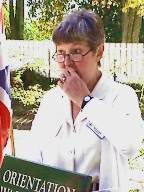 Chief Executive Officer Robert C. Wilburn's
comments about a three point mission. Of equal importance is the
preservation, presentation and institutional strength. As I would
travel through the park over the next several days, I would see
each of these points in action. Following Lorraine's suggestion,
we proceeded to the visitor's center. There is a $5 fee for those
who don't buy one of the three tier tickets. Inside we were
entertained by the short movie "The Story of a Patriot"
starring Jack Lord of Hawaii 5-0 fame. The show, which has been
running for some 40 years now, is believed to have been seen by
over 32 million people making it a major contender for the most
seen motion picture of all times. The film and the park are both
set in the time leading up to the Revolutionary War. The calendar
of events page on the inside of the "Visitor's
Companion", free at the center, will advise of the actual
date being portrayed at the park for that day. The dates change
daily. On this particular day it was April 29, 1775, several days
after the "shot heard round the world", was fired in
Lexington, Ma. The publication, in addition to a complete
schedule of events in the park, has a large centerfold map of the
area. Although the streets of Colonial Williamsburg are still
part of the city, and as
Chief Executive Officer Robert C. Wilburn's
comments about a three point mission. Of equal importance is the
preservation, presentation and institutional strength. As I would
travel through the park over the next several days, I would see
each of these points in action. Following Lorraine's suggestion,
we proceeded to the visitor's center. There is a $5 fee for those
who don't buy one of the three tier tickets. Inside we were
entertained by the short movie "The Story of a Patriot"
starring Jack Lord of Hawaii 5-0 fame. The show, which has been
running for some 40 years now, is believed to have been seen by
over 32 million people making it a major contender for the most
seen motion picture of all times. The film and the park are both
set in the time leading up to the Revolutionary War. The calendar
of events page on the inside of the "Visitor's
Companion", free at the center, will advise of the actual
date being portrayed at the park for that day. The dates change
daily. On this particular day it was April 29, 1775, several days
after the "shot heard round the world", was fired in
Lexington, Ma. The publication, in addition to a complete
schedule of events in the park, has a large centerfold map of the
area. Although the streets of Colonial Williamsburg are still
part of the city, and as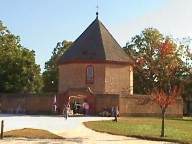 such are open to the public at no cost.
Vehicle traffic is prohibited during the daytime, and parking in
the area is just about impossible. We left our car at the
visitor's center and rode the Red Line bus which connects the
visitor's center to the park. The Blue Line bus will then take
you to all the various attractions around the area. There is no charge for the bus ride. The price of
admission is in line with other major theme parks. From the drop-off point on the Red Line, we walked up a short path to where we
met Betty Oliver who was our guide for the "orientation
walk". This is a great help as it acquainted us with the ins
and outs of the area. She told us that Williamsburg had a
population of around 2000 people at the time of the Revolution.
Betty further explained that as the Colony was still under
British rule at the time, small British flags have been placed in
front of each building
such are open to the public at no cost.
Vehicle traffic is prohibited during the daytime, and parking in
the area is just about impossible. We left our car at the
visitor's center and rode the Red Line bus which connects the
visitor's center to the park. The Blue Line bus will then take
you to all the various attractions around the area. There is no charge for the bus ride. The price of
admission is in line with other major theme parks. From the drop-off point on the Red Line, we walked up a short path to where we
met Betty Oliver who was our guide for the "orientation
walk". This is a great help as it acquainted us with the ins
and outs of the area. She told us that Williamsburg had a
population of around 2000 people at the time of the Revolution.
Betty further explained that as the Colony was still under
British rule at the time, small British flags have been placed in
front of each building 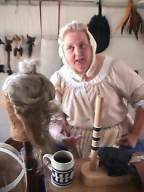 where entrance requires an admission pass.
There were a lot of flags. Betty continued the introduction as we
wandered down the Palace Green toward the Duke of Gloucester
Street. Williamsburg, named for King William III of England,
became the colonial seat after it was moved from Jamestown. It
would remain the center of Virginia government until Thomas
Jefferson, serving as the second governor after the Revolution,
moved the Capitol to Richmond in 1780. The town fell into
obscurity after the Capitol was moved; and by the end of the
Great Depression of the 1920s the old section had been reduced to
not much more then a run down shanty-town. In 1926 the Reverend
Dr. W. A. R. Goodwin, pastor of the Bruton Parish Church
formalized a dream he had nurtured for decades. The restoration
of Williamsburg as a historical showplace. For this he would need
strength, dedication and literally millions of dollars. No easy
task coming at the end of the greatest depression in the
country's history. It would take someone with extraordinary
determination, and wealth. That man was John D. Rockefeller, Jr.
The two men would form a bond which would see thousands of hours
where entrance requires an admission pass.
There were a lot of flags. Betty continued the introduction as we
wandered down the Palace Green toward the Duke of Gloucester
Street. Williamsburg, named for King William III of England,
became the colonial seat after it was moved from Jamestown. It
would remain the center of Virginia government until Thomas
Jefferson, serving as the second governor after the Revolution,
moved the Capitol to Richmond in 1780. The town fell into
obscurity after the Capitol was moved; and by the end of the
Great Depression of the 1920s the old section had been reduced to
not much more then a run down shanty-town. In 1926 the Reverend
Dr. W. A. R. Goodwin, pastor of the Bruton Parish Church
formalized a dream he had nurtured for decades. The restoration
of Williamsburg as a historical showplace. For this he would need
strength, dedication and literally millions of dollars. No easy
task coming at the end of the greatest depression in the
country's history. It would take someone with extraordinary
determination, and wealth. That man was John D. Rockefeller, Jr.
The two men would form a bond which would see thousands of hours of work and millions of dollars poured into an aggressive program
to preserve, restore, or re-create an entire 18th century town.
Their efforts would eventually take the form of the Colonial
Williamsburg Foundation, who today continues those original goals and more, having acquired all but
one house within the historic district. Having completed the
orientation walk, we continued down the Duke of Gloucester Street
to our first British Flag in front of the original arsenal and
magazine building. The magazine was erected in 1715 to store the
arms and ammunition dispatched from London for the defense of the
colony. Lieutenant Governor Alexander Spotswood requested the
construction, personally advanced the necessary funds and may
have provided the unusual octagonal design for the building which
supported military operations as far west as the Ohio Valley. The
building played a prominent position during the Revolutionary
period when, in the early morning hours of April 21, 1775, a week
after the battle of Lexington and Concord, British Sailors and
Marines from the H.M.S. Magdalen, secretly removed most of the
gunpowder from the building but were discovered by the night
watchman as they made their escape. The royal governor, Lord
Dunmore had ordered the removal hoping to prevent open rebellion
in Virginia.
of work and millions of dollars poured into an aggressive program
to preserve, restore, or re-create an entire 18th century town.
Their efforts would eventually take the form of the Colonial
Williamsburg Foundation, who today continues those original goals and more, having acquired all but
one house within the historic district. Having completed the
orientation walk, we continued down the Duke of Gloucester Street
to our first British Flag in front of the original arsenal and
magazine building. The magazine was erected in 1715 to store the
arms and ammunition dispatched from London for the defense of the
colony. Lieutenant Governor Alexander Spotswood requested the
construction, personally advanced the necessary funds and may
have provided the unusual octagonal design for the building which
supported military operations as far west as the Ohio Valley. The
building played a prominent position during the Revolutionary
period when, in the early morning hours of April 21, 1775, a week
after the battle of Lexington and Concord, British Sailors and
Marines from the H.M.S. Magdalen, secretly removed most of the
gunpowder from the building but were discovered by the night
watchman as they made their escape. The royal governor, Lord
Dunmore had ordered the removal hoping to prevent open rebellion
in Virginia. 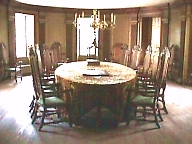 Instead his action pushed enraged Virginians to the
brink of war. Williamsburg's citizens and the city fathers
marched on the governor's palace to petition for the powder's
return but Dunmore refused. Twelve days later Patrick Henry lead
a 150 man armed volunteer company to the outskirts of the town,
demanding the return of the powder. Dunmore relented by paying
some 300 Pounds for the powder. This defused the incident but the
spark of rebellion continued to burn brightly and in early June,
Dunmore moved himself and his family onto a British ship moored
in the York River. He would never return. We continued our stroll
toward the Capitol, stopping at the wig shop to talk to Mistress
Lyons as she finished up a powdered white
wig. When I turned down her offer for a new wig, in her best
British accent, she offered Russian bear grease guaranteed to
make my own hair grow. The sale fell through when she found out I
didn't have English Pounds to pay with. At the Capitol we met the
distinguished Thomas Nelson, a prominent merchant in town who had
taken the afternoon off to show us around the Capitol. We stopped
by the House of Burgesses, the oldest governing body in America.
Made up of two
Instead his action pushed enraged Virginians to the
brink of war. Williamsburg's citizens and the city fathers
marched on the governor's palace to petition for the powder's
return but Dunmore refused. Twelve days later Patrick Henry lead
a 150 man armed volunteer company to the outskirts of the town,
demanding the return of the powder. Dunmore relented by paying
some 300 Pounds for the powder. This defused the incident but the
spark of rebellion continued to burn brightly and in early June,
Dunmore moved himself and his family onto a British ship moored
in the York River. He would never return. We continued our stroll
toward the Capitol, stopping at the wig shop to talk to Mistress
Lyons as she finished up a powdered white
wig. When I turned down her offer for a new wig, in her best
British accent, she offered Russian bear grease guaranteed to
make my own hair grow. The sale fell through when she found out I
didn't have English Pounds to pay with. At the Capitol we met the
distinguished Thomas Nelson, a prominent merchant in town who had
taken the afternoon off to show us around the Capitol. We stopped
by the House of Burgesses, the oldest governing body in America.
Made up of two representatives for each of the eight surrounding
towns, it first met in 1619. Such historic figures as Patrick
Henry and Thomas Jefferson were representatives. Although it served at the whim
of the Governor, the House of Burgesses was charged with
regulating those things found necessary that were not of concern
to the British Crown. It formed the nucleus of the State
Government once independence was declared. Mr. Nelson also showed
us the colonial courtroom where the most serious of crimes, such
as murder and treason were tried. Williamsburg also had a City
Government and its own courthouse which heard the lesser cases
such as fighting and petty thefts. In departing the Capitol building we
stopped by a minstrel show and listened to the songs of the time.
This was part of the continuing activities that abounded about
us. It gave the entire area a feeling of reality. The only
element that kept me from falling into the moment was the massive amount of
tourists that were everywhere. Outside the courtyard, the Williamsburg militia was encamped. Corporal Hector had the picket
duty for the day, and we quickly engaged into conversation over
the advantage of different kinds of muskets. In making his point,
he loaded up the musket he was carrying, demonstrating each
component, as he tore open a paper cartridge wrapper with his
teeth, then poured the power in the barrel before he primed the
gun. With a thunderous bang and cloud of white smoke, he fired
the musket down range.
representatives for each of the eight surrounding
towns, it first met in 1619. Such historic figures as Patrick
Henry and Thomas Jefferson were representatives. Although it served at the whim
of the Governor, the House of Burgesses was charged with
regulating those things found necessary that were not of concern
to the British Crown. It formed the nucleus of the State
Government once independence was declared. Mr. Nelson also showed
us the colonial courtroom where the most serious of crimes, such
as murder and treason were tried. Williamsburg also had a City
Government and its own courthouse which heard the lesser cases
such as fighting and petty thefts. In departing the Capitol building we
stopped by a minstrel show and listened to the songs of the time.
This was part of the continuing activities that abounded about
us. It gave the entire area a feeling of reality. The only
element that kept me from falling into the moment was the massive amount of
tourists that were everywhere. Outside the courtyard, the Williamsburg militia was encamped. Corporal Hector had the picket
duty for the day, and we quickly engaged into conversation over
the advantage of different kinds of muskets. In making his point,
he loaded up the musket he was carrying, demonstrating each
component, as he tore open a paper cartridge wrapper with his
teeth, then poured the power in the barrel before he primed the
gun. With a thunderous bang and cloud of white smoke, he fired
the musket down range.
